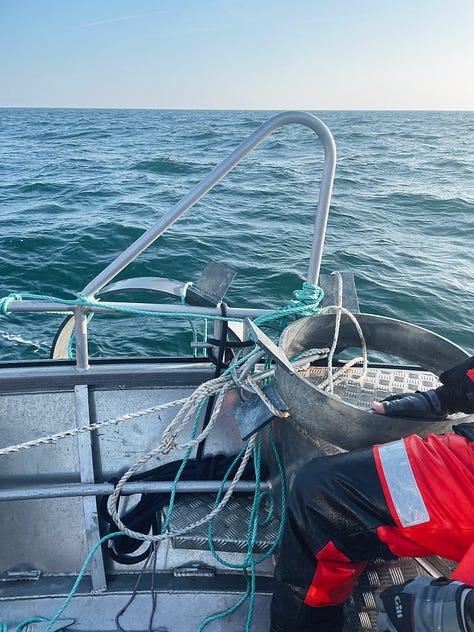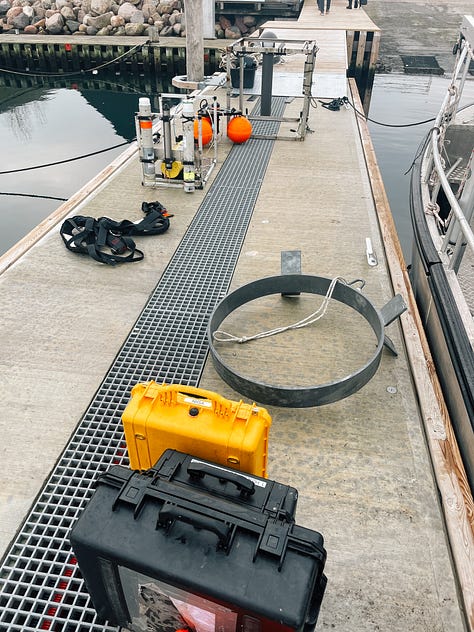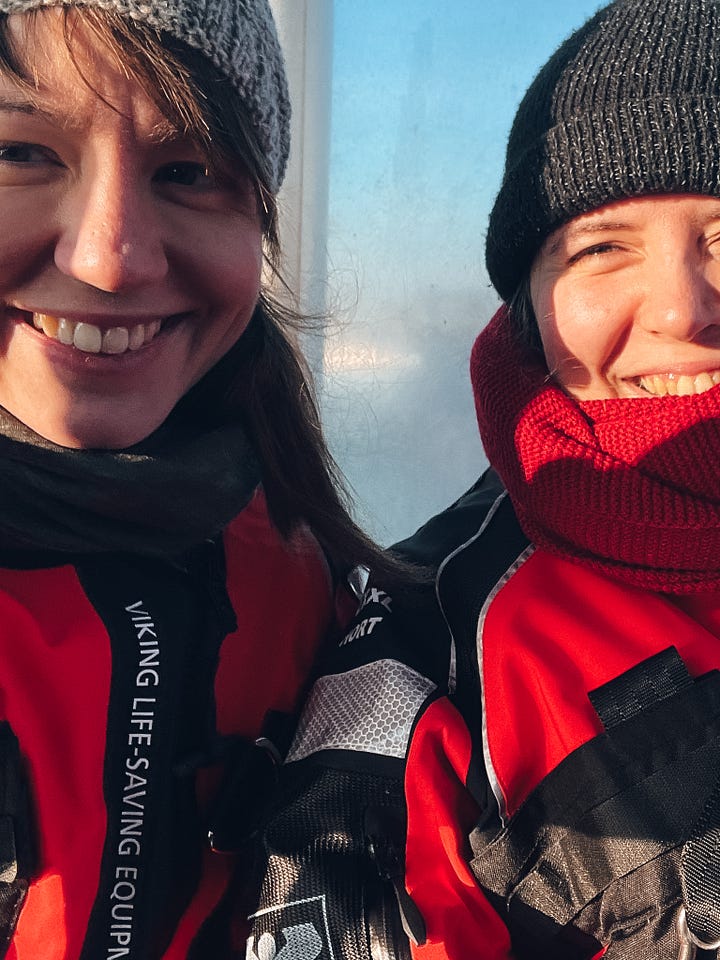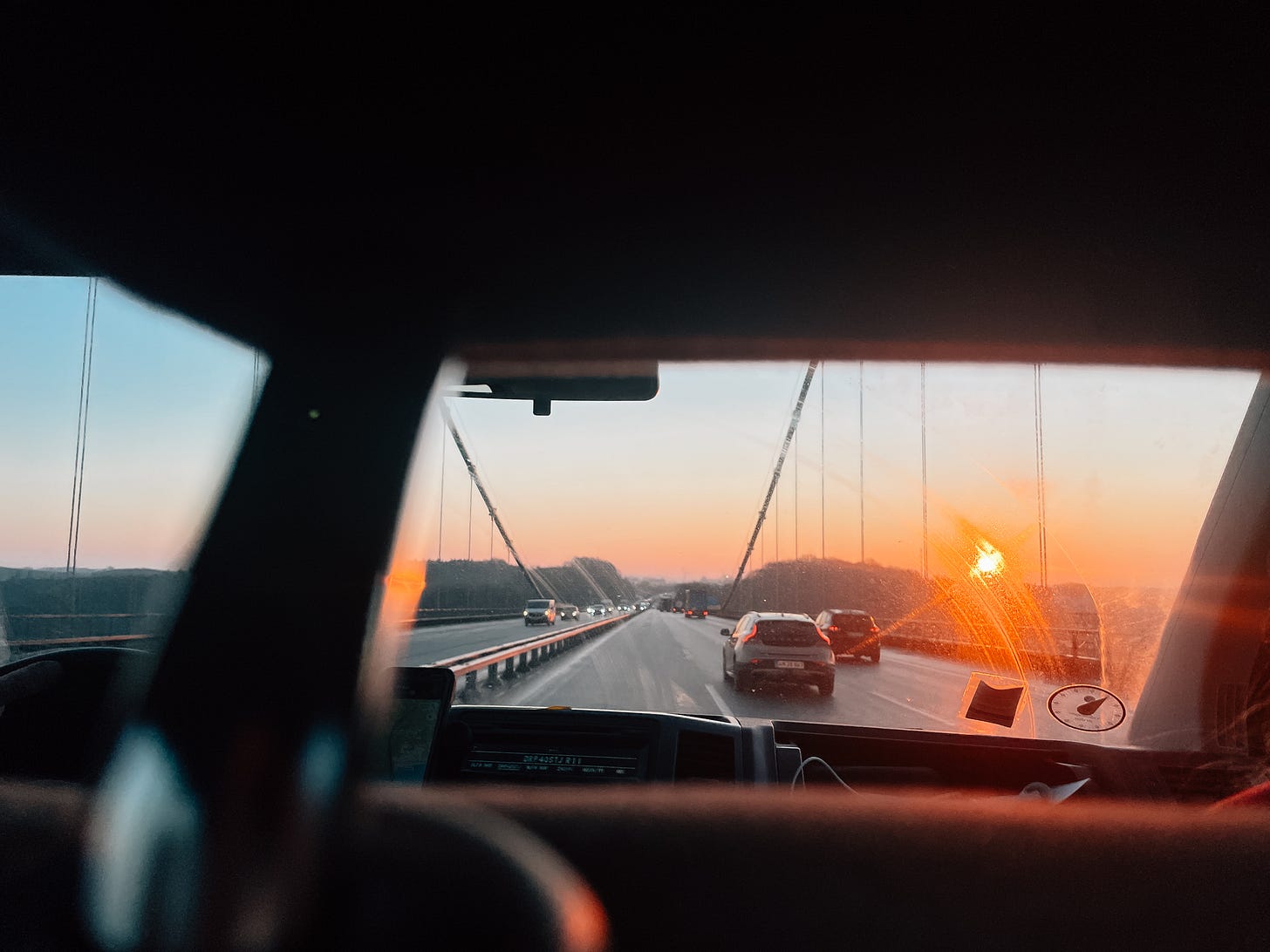The foresight of getting out towards the wintery waters of Denmark in a small open boat on a dark and early Monday morning is not exactly exhilarating.
It is also probably the first image your brain pops to you when thinking about field work of a marine scientist. But well, not all of us work in the calm waters of sunny Florida 🤣.
Add to that the logistics of being a woman in a full body working suit, trying to figure out the exact point between “last sip of highly needed morning coffee” and the “last option to pee” for an unforeseeable amount of hours.
But a girl has to do what a girl set out to do. I mean girls. My PhD partner in crime was joining, along with a technician and we would meet the captain of the day down at the marina.
And so we left the university in Aarhus at 7 am to drive once again down to Storebælt (approximately 2 hours). This time departing from Kerteminde (the cosiest and most typical Danish coastal town you can imagine).
When we past the Lillebælt bridge, the sun has started to rise in the cold winter air and gave us some very dreamy vibes.
We found a gas station to be the best “last option for a pee” since most of the small marinas have their facilities closed during the winter months.
We met with the captain, checked the forecast and condition for a last time (still some wind, but supposed to calm down) and then lowered NIISA into the water. I am always fascinated by how relatively effortlessly those boat trailers transfer a boat from dry hibernation into its natural environment. And I got a wee bit proud when I applied one of the knots I had just learned to secure the boat at the dock 😎. Next, we brought the safety and working equipment.
We parked the cars and got ready to suit up. With temperatures around 0-5 Celsius but wind chill below 0, I usually wear a pair of Merino tights and thick wool socks for the lower body, a merino sleeveless top, a merino thin longsleeve and a thick wool pullover for the upper body. And then of course the insulated suit. And a buff, hat and gloves.
Niisa has a little semi-open shelter around the steering and navigation area which nicely fitted all four of us.
The water was still a bit rough driving out and I had the joy of getting a splash of sea spray into my face with every other wave we crashed. Despite the sun really reminding us of its presence (had not seen her in a long while), the wind and salt on my skin soon felt like tiny needles and I tried to squeeze myself into the corner of the shelter.
We reached our destination about an hour later. Right in the middle of the main shipping route into the Baltic sea. The mission for today was to recover two pieces of recording equipment from the sea floor. With 30 m, the area is pretty shallow, but the rig consisted of more than 100 m of ropes, two metal constructions with the instruments, and two heavy anchors to keep everything in place.
Add to that a small boat in ruffled waters and big tankers around you. After making sure our GPS position matched closely with the one that the instruments were supposed to be, my colleague and I opened the deck unit of the acoustic releases. It is essentially a trandsducer (hydrophone that can send and receive pings in the water) that is connected to an electronic device box that allows sending and interpreting the pings. So we sent out a ping to the releaser down at the seafloor to first confirm that it is there and second give the command that it should release and start floating up. This will make the releaser and a piece of rope float up that can then be used to pull everything on board. That first part worked a charm, and the releaser came up.
Afterwards, things did not fully go to plan. We spent 2 hours and all of our physical and creative energy problem-solving entangled ropes, ripping ropes, lack of space on the small boat, lifting out of the waves, securing and retrieving parts of the construction piece by piece.



But we got it all recovered with the sensitive instruments all being safe and sound and us being salty, exhausted, muddy - and smiley.
On the way back to the marina, I felt so cosy in my survival suit, the humming of the motor and the rolling of the waves that I had the best nap in like forever 😄.
To me, there is something unique about working out at sea. From the moment I get ready, there is a single focus that at the same time includes being aware of all the necessary surroundings.
But without any mental fuss and clutter.
Out there on a small boat in the waves, nothing really matters but that tiny boat, the trust among the people you are with and the job you have to do. With a single priority of keeping everyone safe. This includes the very individual perception of what still feels safe and manageable for one.
There is not much talking except for calm coordination and a friendly chat in between - but there is also much being together without needing to talk.
If I still did not want to go out into the elements during the car ride, it felt like the best thing ever when out on the boat.
You get wet, you get dirty, you get the salty needle spikes right to the sensitive skin of your face. You feel the sun, the waves, the humming of the engine. You can sense the tension on the ropes by just looking at it.
You can feel your muscles tighten, trying to hold on to or pull the equipment. There is no room for ego. If you feel like you can’t hold onto anymore, you have to tell the others to not loose the equipment or put yourself or others at risk.


I freaking love my job.
And not just for the pure reason of being paid while having the best afternoon nap in a while.
What else happened this this week
Monday: Fieldwork to recover equipment 🙂
Tuesday & Thursday: At university, working on some data analysis + cleaning the equipment
Wednesday: Working from home
Friday: Our supervisor took me and two other PhD students to a meeting back in Kerteminde to discuss some regulatory aspects of underwater noise in Europe. This smaller part of the bigger meeting was held at the Fjord & Bælt centre, which is a shared facility by researchers from the Southern University of Denmark and a public marine education center. (There are captive animals living there which I know is a sensitive and controversial topic, but as a scientist, I have to appreciate that there is a fine balance that must be applied between being able to do conservation-based research and avoiding captive animals at all).
Random things I learned
Water is not wet (from a human-sensory perspectivce)
Physiologically, us humans cannot perceive the state of “wet”.
Like our skin is not able to tell that something is wet. We just can feel warm or cold and together with the awareness and sensemaking of our surroundings, we define that something is wet.
That is pretty strange and fascinating to me. Like this means, I was only able to feel the cold splashes of water in my face as cold and spiking. But my brain instantly registered it as “wet”.
Up next
Next week, Sven and I are participating in cooking a communal dinner with neighbours of our living area. On Monday, I have my very first doctor’s appointment - let’s see how I feel about the Danish healthcare system afterwards.
And on Thursday + Friday, we have a section seminar at work which incldues two days of meeting new people in my research unit and - as far as I understand - participating in different workshops. We will also have an overnight stay at a small seminar house.
Hug,










